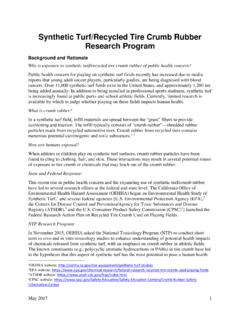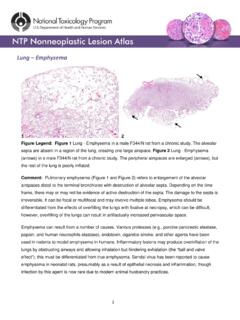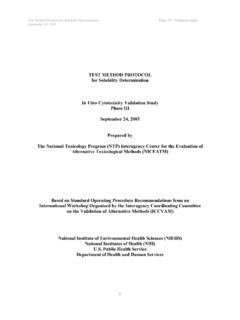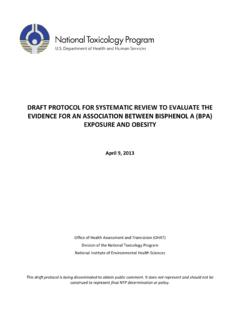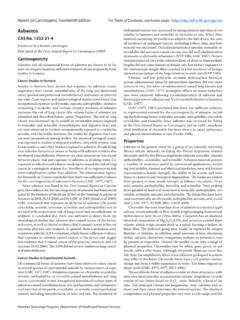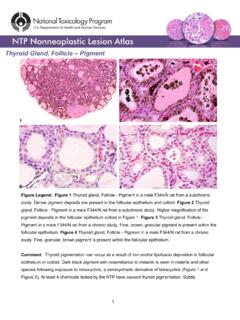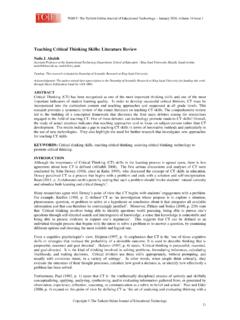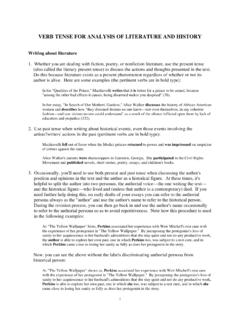Transcription of infrasound review 013102 - National Toxicology Program
1 infrasound Toxicological Summary November 2001. infrasound Brief review of Toxicological literature November 2001. 1. infrasound Toxicological Summary November 2001. Preface (Revised March 2002). Recent interest in the potential adverse human health effects of infrasound (generally inaudible sound with a frequency of <20 Hz) arises from health concerns expressed by the residents of Kokomo, Indiana. Several individuals in this community have complained of subjective non-specific symptoms including annoyance, sleep disturbance, headaches, and nausea.
2 These symptoms are perceived by the individuals to be due to a low-frequency hum-like noise in and around their homes that is not clearly audible to everyone. Several local, state, and federal agency officials as well as acoustic experts in the academic community and private sector have been called upon to assist in investigating these health complaints. As yet, no firm conclusions have been reached regarding the relationship between this low-frequency noise and the residents' health complaints. Subsequent to inquiries from the Senators from Indiana, the National Institute of Environmental Health Sciences (NIEHS) agreed to review the existing scientific literature on the health effects of infrasound .
3 This review was intended to serve as an initial step in determining whether sufficient information is available to make a reasonable assessment of the potential for adverse human health effects to occur as a result of infrasound exposure. Consequently, the NIEHS is nominating toxicological studies of infrasound for consideration by the National Toxicology Program (NTP) to seek broad federal agency and public input regarding the need for further federal sponsored experimental animal Toxicology research on this environmental agent.
4 This document briefly summarizes studies identified in the open literature relating to the biological and other effects of infrasound exposure in humans and laboratory animals. The literature searches were performed in August- September, 2001 and the search strategy is briefly described in Section Over one hundred relevant studies were identified that differed widely in their experimental design and selection of endpoints for evaluation. This study variability somewhat limits the conclusions that can be drawn regarding the potential to cause adverse health effects in humans without further expert evaluation and review .
5 The measurement of intensity of sound is the sound pressure level (SPL), usually given in decibels (dB). Sound is a complex physical phenomenon and no attempt is made here to describe in detail acoustic principles or methods for the measurement of sound. Furthermore, the physiological and psychological effects of higher frequency sound and noise comprise an enormous volume of literature and have not been reviewed at this time. This literature is relevant because effects of different sound frequencies could be similar and because in environmental settings human exposure to infrasound rarely if ever occurs in the absence of exposure to other sound frequencies.
6 Many of the infrasound studies identified in the literature search are not available in English or are otherwise difficult to acquire, and thus not all articles have been obtained at this time. The individual study summaries are presented as an annotated bibliography and in many cases are based only on review of an English abstract. Attention has not been given to an evaluation of individual study quality or to the strength of the overall evidence regarding potential adverse health effects. This would require a more thorough and independent expert review to draw conclusions regarding adverse human health effects attributable to infrasound exposure.
7 Rather, the document focuses on identifying and describing the available literature regarding reported physiological and/or psychological effects of infrasound . This document has not been formally peer-reviewed at this time. Experimental studies have been reported where humans or various species of animals (rats, mice, guinea pigs, chinchillas) have been exposed to infrasound in the laboratory. Most of the studies identified involved exposures at 90 dB and higher and ranged from minutes to several months. Of the many animal studies identified, there were none involving long-term (six months or greater) exposure and few that employed modern Toxicology testing protocols and pathological assessments.
8 The most common endpoints studied were behavioral, sensory, or simple physiological ( blood pressure) changes. Some studies focusing on biochemical, cellular, or morphological changes in organs and tissues were identified. There were few studies evaluating reproductive function, developmental effects, and immunological effects, and no studies that evaluated carcinogenic effects. Most studies reported some effects attributed to infrasound exposure, though many studies also reported no observable effects. Among the more consistent findings in humans were changes in blood pressure, respiratory rate, and balance.
9 These effects occurred after exposures to infrasound at levels generally above 110 dB. Physical damage to the ear or some loss of hearing has been found in humans and/or animals at levels above 140 dB. As many studies evaluated endpoints that may or not necessarily be considered adverse, a careful evaluation of the biological significance and reversibility of any reported findings is critical. Due to differences in auditory 2. infrasound Toxicological Summary November 2001. perception and physiological response to sound, the relevance of animal studies to assessing potential human effects must also be carefully evaluated.
10 An evaluation of consistency in reported effects among the different studies identified is made difficult due to limited details available for this review on methods of generating infrasound , characterization of the experimental exposures, and methods of assessing biological effects. For example, other sound frequencies may have been present in some experiments and effects of exposure to pure tones versus broadband frequency may be different. Thus, it is not clear if "environmental" infrasound , in terms of intensity level, frequency range, and frequency composition, has been adequately reproduced in laboratory experiments.
